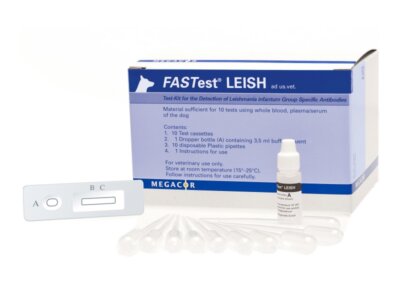
If you haven’t yet heard about canine leishmaniosis (Canl or CaniLeish), one thing is certain – you will, and very soon. Here’s why your vet might need to test for Leishmania, and what you can do to protect your dog when travelling abroad in high-risk areas.
In the same way, the malaria microbe Plasmodium uses mosquitoes to transfer between victims, Leishmania microbes use sandflies to infect dogs, other animals and humans.
Temperatures before climate warming
Before climate warming, British dog owners travelling in northern Europe could be sure that leishmaniosis wouldn’t be a problem. Blood-sucking sandflies need temperatures above 15.6oC for at least three months of the year and can’t easily survive winters below 10oC. The rise in average temperatures means that sandflies now range throughout Spain, Italy, southern and central France and even as far as the French coast of the English Channel.
Travelling with your dog in any of these countries means you need to be aware of the Leishmaniosis risk, especially as infection can be hard to spot, with symptoms developing only months or even years later.
Leishmania infiltrates the defending white blood cells
Once in your dog’s bloodstream, Leishmania infiltrates the defending white blood cells. Infected white cells carry the invaders into your dogs liver, spleen, bone marrow and lymph nodes. Eventually, your dog might develop skin sores or become more and more lethargic or feverish. Bleeding from the nose, lameness and kidney failure might also follow.
A number of treatments for Leishmaniosis are available but require long courses of medication. Large-scale attempts to control sandflies has so far proved ineffective, and the long-term effectiveness of the available CaniLeish vaccines is still uncertain.
Stay Safe – Steer Clear of Sandflies
For now, the most reliable protection your dog has when travelling in high-risk Leishmaniosis infected areas is you.
Keep your dog indoors at dusk and overnight when sandflies are feeding, especially during the high-risk months of April to November. Use mosquito nets on windows and doors and insecticide room sprays and collars as recommended by your vet. Avoid exposing your dog to the dank and stagnant swamps where sandflies breed.
If you think your dog might have been exposed to sandflies or shows symptoms of Leishmaniosis, visit your vet as soon as possible. Using a quick and accurate veterinary diagnostic test such as the reliable Megacor FASTest®LEISH your vet be able to put your mind at rest or get that crucial early start on the best course of treatment for your dog.

